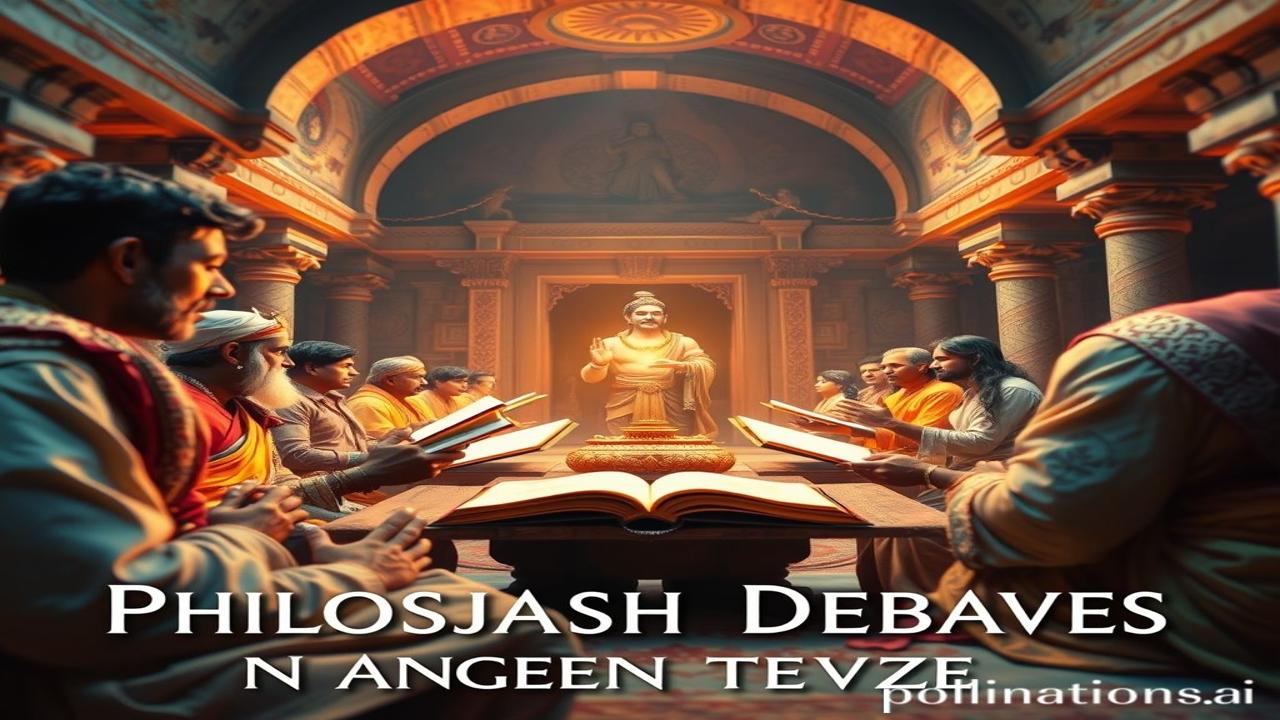Waqt Ki Ret Mein Dabi Dhwani: Ancient Philosophical Debates
Kabhi socha hai, agar hum apne ancestors ki soch ko sun paate, unke arguments ko jaan paate, toh kaisa lagta? Imagine, 5000 saal pehle, Bharat ki dharti par, kuch log aag ke around baithe hain, aur jeevan ke sabse mushkil sawalon par debate kar rahe hain. Kya sach hai? Kya galat hai? Is duniya ka matlab kya hai? These weren’t just abstract ideas; they were the foundations upon which our civilization was built. Waqt ki ret mein dabi, woh dhwani aaj bhi humari rooh mein goonjti hai.
The Seeds of Thought: Historical and Cultural Context
Ancient Indian texts, like the Vedas, Upanishads, Bhagavad Gita, and various schools of philosophy like Samkhya, Yoga, Nyaya, Vaisheshika, Mimamsa, and Vedanta, are not just religious scriptures; they are treasure troves of philosophical debates. These debates blossomed between 1500 BCE and 500 CE, primarily in the Gangetic plains of India.
Think of it this way: While other civilizations were focused on conquering territories, ancient India was busy conquering the mind! These philosophical schools offered diverse perspectives on the nature of reality (Brahman), the self (Atman), the cycle of birth and death (Samsara), and the path to liberation (Moksha). For example, the Charvaka school, known for its materialistic philosophy, questioned the existence of an afterlife and the efficacy of Vedic rituals – a truly radical idea for its time! It’s important to remember that these weren’t just academic exercises; these debates shaped ethics, governance, art, and every aspect of life in ancient India.
Zameeni Sach: People and Life in the Age of Inquiry
Imagine a bustling university like Nalanda or Takshashila. Students from all corners of the world flocked there, not just to learn about mathematics and astronomy, but also to engage in intense philosophical discussions. Picture a young artisan, diligently carving intricate details on a temple wall, contemplating the concepts of Maya and Lila – the illusion and divine play of the universe.
Picture a saffron-robed monk, debating with a royal advisor about the principles of dharma (righteousness) and artha (wealth) necessary for just governance. “Maharaj,” the monk might say, “Rajdharma sirf satta paane ka nahi, balki praja ka kalyan karne ka bhi marg hai.” Ma Rukmini, perhaps, seeking solace in the teachings of the Bhagavad Gita amidst the daily pressures of running a household, finds answers to questions about her purpose and duties. From the rulers to the farmers, everyone was touched by these philosophical currents. Their clothes, their tools, their dreams – everything was infused with the spirit of inquiry.
Dharohar Aur Pehchan: Echoes in Modern India
Today, the reverberations of these ancient debates are everywhere in India. Our festivals, our rituals, our art – they all carry echoes of these philosophical underpinnings. Think of Diwali, the festival of lights, which symbolizes the triumph of good over evil, echoing the philosophical struggle between dharma and adharma. The concept of ‘Karma’ is deeply ingrained in our collective consciousness, guiding our actions and shaping our understanding of cause and effect. Even modern Indian philosophers and thinkers draw inspiration from these ancient texts, reinterpreting them for contemporary contexts. This rich philosophical heritage is intrinsic to Bharatiyata, our Indianness, providing a unique lens through which we view the world.
Mazedar Tathya: Myth-Buster Moment
Log samajhte hain ki ancient Indian philosophy sirf spirituality aur religion ke baare mein hai, lekin asli sach yeh hai ki it encompassed a wide range of disciplines, from logic and epistemology to ethics and political thought. The Charvaka school, often dismissed as hedonistic, actually offered a sophisticated critique of Vedic authority and advocated for empirical observation as the primary means of knowledge. This challenges the common misconception that ancient India was solely focused on the metaphysical.
Drishya Aur Bhavnayein: Painting a Sensory Picture
Imagine the air thick with the scent of incense and sandalwood, the sound of chanting mantras echoing through the halls of a monastery. Feel the cool, smooth touch of marble floors beneath your bare feet as you enter a temple dedicated to Shiva. See the flickering flames of oil lamps illuminating the faces of scholars engaged in a heated debate, their voices rising and falling like the waves of the ocean. These were not sterile, academic exercises; they were vibrant, living experiences that engaged all the senses and stirred the soul.
Antim Vichar: A Timeless Echo
“Yato dharma stato jayah” – Where there is dharma, there is victory. This ancient saying, born from the heart of those philosophical debates, reminds us that the pursuit of truth and righteousness is the ultimate path to success. These ancient debates weren’t just about finding answers; they were about cultivating a mindset of inquiry, critical thinking, and ethical living – values that are just as relevant today as they were millennia ago. The whispers from the past urge us to continue the quest for knowledge and understanding, to engage with the world in a thoughtful and compassionate way, and to build a future worthy of our ancestors.
